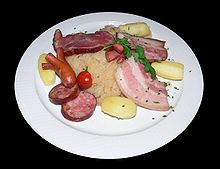- Choucroute garnie
-
Choucroute garnie (French for dressed sauerkraut; choucroute is a phonologically francophonic form of Alsacian Sürkrüt, c.f. German Sauerkraut) is a famous Alsacian recipe for preparing sauerkraut with sausages and other salted meats and charcuterie, and often potatoes.
Although sauerkraut is a traditionally German and Eastern European dish, the French annexation of Alsace and Lorraine following the Peace of Westphalia in 1648 brought this dish to the attention of French chefs and it has since been widely adopted in France.
In principle, there is no fixed recipe for this dish - any preparation of hot sauerkraut with meat and potatoes could qualify - but in practice there are certain traditions, favourite recipes, and stereotypical garnishes that are more easily called choucroute garnie than others. Traditional recipes call for three types of sausage: Frankfurt sausages, Strasbourg sausages, and Montbéliard sausages. Fatty, inexpensive or salted cuts of pork also often form a part of choucroute garnie, including ham hocks, pork knuckles and shoulders, back bacon and slices of salt pork. Other recipes call for pieces of fish or goose meat, but this is far less typical.
The sauerkraut itself is usually heated with a glass of Riesling or other dry white wines or stock, and goose or pork fat. In some recipes, it may also be cooked with chopped onion and sliced apples. Food writer Jeffrey Steingarten attempted to catalogue the composition of an authentic recipe in 1989. He writes that every traditional recipe includes black peppercorns, cloves, garlic, juniper berries, onions, and potatoes; most include bay leaves and wine.
Like cassoulet, pot au feu, and so many other examples of France's regional cuisine, its origin is in a traditional, inexpensive dish, but grand versions (such as Choucroute Royale, made with Champagne instead of Riesling), and grand ingredients (such as foie gras and wild game) are mentioned both in traditional sources (e.g. Ali-Bab[1]) and in recipes from contemporary chefs and restaurants.
Choucroute garnie is available throughout France in canned or microwavable ready-to-eat form. A Hungarian version includes stuffed cabbage leaves in addition to the other ingredients. Shredded cabbage can also be added along with the sauerkraut to produce a somewhat less acidic version.
Contents
Recipe for choucroute of white cabbage
(Serves 4)
- 125g butter
- a handful of fine, diced Alsace bacon or smoked streaky bacon
- 1 white cabbage, finely sliced
- 750ml white wine
- 250ml good-quality white wine vinegar
- bouquet garni (garlic/thyme/rosemary/bay leaf)
- bouquet garni (star anise/cinnamon stick/coriander seeds/juniper berries) tied in a muslin cloth
- 100g honey or chutney or jam
to serve
- grilled continental sausage or simmered ham hock, carrots and potatoes
Heat the butter in a pan, add the bacon and gently sauté until lightly coloured. Pour over the white wine and white wine vinegar and add both bouquets garnis. Cover with a tight fitting lid. Gently simmer the cabbage until most of the liquid has evaporated, then add honey and check the seasoning.
Trivia
Choucroute in French is also the name of a sort of beehive hair style with a slightly disorderly appearance, first sported by French actress Brigitte Bardot in the 1960s. Her blond hair arranged in such a hairstyle was deemed reminiscent of choucroute heaped high on a plate, hence the name.
References
- ^ Ali-Bab, Gastronomie pratique: Une bible gourmande en 5000 recettes, ISBN 2082007286
Sources
- Sauerkraut in Larousse Gastronomique, US edition. ISBN 0517570327
- Steingarten, Jeffrey (1997). "True Choucroute". The Man Who Ate Everything. Vintage Books. pp. 237–248. ISBN 0-375-70202-4. The chapter is an essay first published in 1989.
Notes
Categories:- French cuisine
- French words and phrases
Wikimedia Foundation. 2010.

